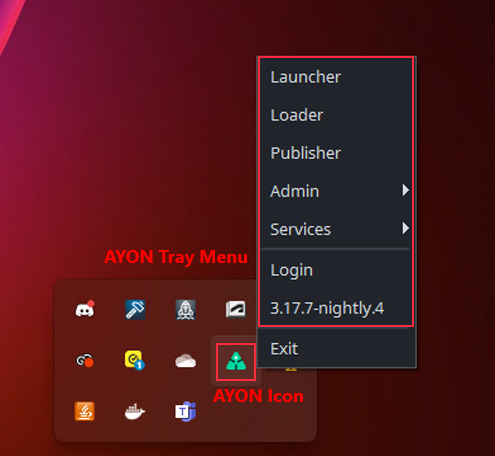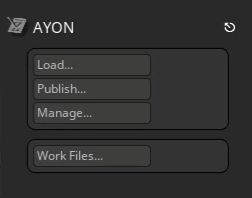Zbrush Artist Docs
First Steps With AYON
Locate AYON Icon in the OS tray (if hidden dive in the tray toolbar).
If you cannot locate the AYON icon ...it is not probably running so check Getting Started first.
By clicking the icon AYON Menu rolls out.

Choose AYON Menu > Launcher to open the Launcher window.
When opened you can choose the project to work in from the list. Then choose the particular asset you want to work on then choose task and finally run zbrush by its icon in the tools.

The list of available projects, assets, tasks and tools will differ according to your Studio and need to be set in advance by supervisor/admin.
Running in the Zbrush
If Zbrush has been launched via AYON Launcher there should be AYON Menu visible in Zbrush top header after start.

The AYON Menu is moveable which allows user to drag it to the right corner.
The AYON menu located in the right corner would look like this:

This is the core functional area for you as a user. Most of your actions will take place here.
User should use this menu exclusively for Opening/Saving when dealing with work files not standard File Tool even though user still being able perform file operations via this menu but preferably just performing quick saves during work session not saving actual workfile versions.
Working With Scene Files
In AYON menu first go to Work Files menu item so Work Files Window shows up.
Here you can perform Save / Load actions as you would normally do with Save As and Open in the Zbrush File Tool and navigate to different project components like assets, tasks, workfiles etc.

You first choose particular asset and assigned task and corresponding workfile you would like to open.
If not any workfile present simply hit Save As and keep Subversion empty and hit Ok.
AYON correctly names it and add version to the workfile. This basically happens whenever user trigger Save As action. Resulting into incremental version numbers like
workfileName_v001
workfileName_v002
etc.
Basically meaning user is free of guessing what is the correct naming and other necessities to keep everything in order and managed.
Understanding Context
As seen on our example AYON created pretty first workfile and named it il_modelCreature_head_v002.zpr meaning it sits in the Project il being it modelCreature folder path and workfile being head task and obviously v002 telling user its first existing version of this workfile.
It is good to be aware that whenever you as a user choose folder path and task you happen to be in so called context meaning that all user actions are in relation with particular folder path. This could be quickly seen in host application header and AYON Menu and its accompanying tools.

Whenever you choose different
folder pathand itstaskin Work Files window you are basically changing context to the current asset/task you have chosen.
This concludes the basics of working with workfiles in Zbrush using AYON and its tools. Following chapters will cover other aspects like creating multiple folder paths and their publishing for later usage in the production.
Creating and Publishing Instances
Before proceeding further please check Glossary and What Is Publishing? So you have clear idea about terminology.
Intro
Current AYON integration supports only Model product types now.
Model product type being any mesh outputted as either ABC, FBX or OBJ format, depending on what users choose as export output.
Publishing Model
Go AYON -> Create and select Model. Make sure to select your geometry in the subtool menu before Publish.Users can also choose subdivision level before the export. The subdivision level is set to 0 by default, which asks Zbrush to export the mesh in the current subdivision level.
Loading Model
You can load the model from other DCCs via AYON -> Load. It imports the model in the formats such as ABC, FBX, OBJ and MA.

